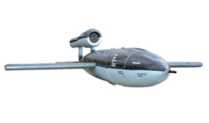Fieseler Fi 103 (V1)
| Serial No: | n/a |
| Period: | WWII |
| Reference: | 85/O/48 |
| Museum: | Midlands |
| Location: | War in the Air |
| On Display: | Yes |
The V1 (Vergeltungswaffe or Vengeance Weapon 1) was devised as a flying bomb as early as 1935, but because of design problems, progress was slow and little priority was given to the project.
The first production order was not made until June 1942. However, it was not until 13 June 1944 that the first ten were launched against London and by 29 June, approximately 2,000 had been launched from 40 operational sites. Only one in four V1s launched actually reached London and on 2 March the last of the successful launches hit our Capital.
The bombs themselves were controlled in flight by a gyroscope which operated the rudder and elevator whilst a pre-set air log, driven by the small propeller on the nose caused the bomb to dive or glide onto its target. The whole system was rather crude and was not capable of achieving great accuracy.
The V1 was perhaps the world’s first cruise missile and the first guided missile to be used en masse. The pulsejet engine had a grid of flap-valve springs in its inlet, which alternately admitted fresh air and then were blown shut against ram pressure by the ignition of the duct. The vibration made the engine noise and led to the infamous ‘buzz-bomb’ noise which would suddenly stop when the V1 was over its target.
At least 29,000 missiles were produced although the saturation attacks Hitler envisaged never took place, with the most efficient unit firing 316 on one day.






